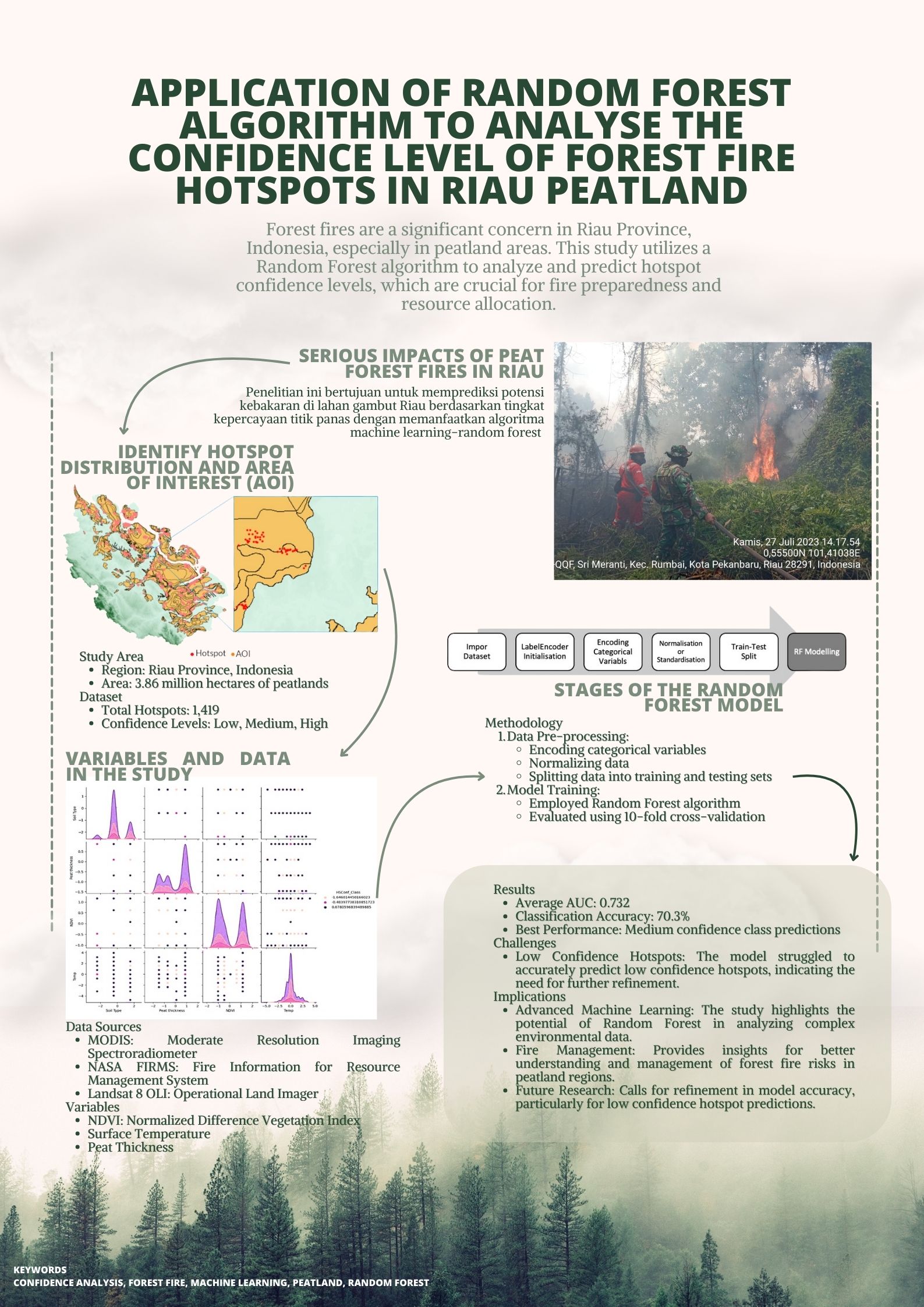Application of Random Forest Algorithm to Analyze the Confidence Level of Forest Fire Hotspots in Riau Peatland
Abstract
Forest fires pose a significant challenge in Riau Province, Indonesia, especially in peatland areas. This study employs the Random Forest (RF) algorithm to analyze the confidence levels of hotspots, aiming to predict potential fire occurrences and improve fire management strategies. The research focuses on peatlands spanning 3.86 million ha, using key variables such as NDVI, surface temperature, and peat thickness derived from satellite data. The model achieved an average AUC of 0.732 and a classification accuracy of 70.3%, with medium-confidence hotspots demonstrating the best predictive performance (AUC: 0.707, F1-score: 0.804). However, the model struggled with low-confidence hotspots, reflecting challenges in distinguishing less prominent patterns in the data. Compared to other methods, RF demonstrates strong potential in handling complex environmental datasets, making it a valuable tool for hotspot prediction. This study contributes to understanding forest fire risks in peatlands and provides actionable insights for improving preparedness and mitigation efforts.
References
De Angelis A, Ricotta C, Conedera M, Pezzatti GB. 2015. Modelling the meteorological forest fire niche in heterogeneous pyrologic conditions. PLoS One. 10(2):e0116875.
Belenguer-Plomer MA, Chuvieco E, Tanase MA. 2017. Sentinel-1 based algorithm to detect burned areas. In: Conference 11th EARSeL Forest Fires SIG, Chania, Greece.
BPS Provinsi Riau. 2020. Provinsi Riau Dalam Angka. Pekanbaru.
Choubin B, Soleimani F, Pirnia A, Sajedi-Hosseini F, Alilou H, Rahmati O, Melesse AM, Singh VP, Shahabi H. 2019. Effects of drought on vegetative cover changes: Investigating spatiotemporal patterns. Elsevier Inc.
Dutta R, Das A, Aryal J. 2016. Big data integration shows Australian bush-fire frequency is increasing significantly. R Soc Open Sci. 3(2):150241.
Giglio L, Schroeder W, Justice CO. 2016. The collection 6 MODIS active fire detection algorithm and fire products. Remote Sens Environ. 178:31–41. doi:10.1016/j.rse.2016.02.054.
Global Wetlands. 2019. The Global Wetlands Map. Sustainable Wetlands Adaptation and Mitigation Program (WWAMP). [accessed 2022 Feb 5]. https://www2.cifor.org/global-wetlands/.
Hayasaka H, Yamazaki K, Naito D. 2019. Weather conditions and warm air masses during active fire-periods in boreal forests. Polar Sci. 22:100472.
KLHK. 2019. Rekapitulasi Luas Kebakaran Hutan dan Lahan (Ha) Per Provinsi Di Indonesia Tahun 2014-2019. SiPongi. [accessed 2019 Dec 10]. http://sipongi.menlhk.go.id/hotspot/luas_kebakaran.
LAPAN. 2020. Panduan Website LAPAN Fire Hotspot. Report No.: 2.
Magadzire N, De Klerk HM, Esler KJ, Slingsby JA. 2019. Fire and life history affect the distribution of plant species in a biodiversity hotspot. Divers Distrib. 25(7):1012–1023.
Murphy KP. 2012. Machine learning: a probabilistic perspective. MIT press.
Nadeem K, Taylor SW, Woolford DG, Dean CB. 2020. Mesoscale spatiotemporal predictive models of daily human- and lightning-caused wildland fire occurrence in British Columbia. Int J Wildland Fire. 29(1):11–27. doi:10.1071/WF19058.
Nurpratami ID, Sitanggang IS. 2015. Classification Rules for Hotspot Occurrences Using Spatial Entropy-based Decision Tree Algorithm. Procedia Environ Sci. 24:120–126. doi:10.1016/j.proenv.2015.03.016.
Osaki M, Nursyamsi D, Noor M, Wahyunto, Segah H. 2016. Peatland in Indonesia. Tropical peatland ecosystems.:49–58.
Panjaitan A, Pujiastuti TT, D MI. 2019. Satellite Perspective Of 2019 ’ S Forest Fire Disaster In Indonesia. Melbourne.
Rawlings N. 2011 Jun 8. Top 10 Devastating Wildfires - Indonesia Wildfire, 1997. Time.:10.
Schikowski T, Altuğ H. 2020. The role of air pollution in cognitive impairment and decline. Neurochem Int. 136(February):104708. doi:10.1016/j.neuint.2020.104708.
Schindele W. 1989. Report on Investigation of the Steps Needed to Rehabilitate the Areas of East Kalimantan Seriously Affected by Fire.
Shofiana DA, Sitanggang IS. 2021. Confidence Analysis of Hotspot as Peat Forest Fire Indicator. J Phys Conf Ser. 1751(1). doi:10.1088/1742-6596/1751/1/012035.
Statistik KLHK. 2020. Luas Kawasan Hutan dan Kawasan Konservasi Perairan Indonesia Desember 2018. Badan Pusat Statistik Indonesia. [accessed 2020 Mar 23]. https://www.bps.go.id/statictable/2013/12/31/1716/luas-kawasan-hutan-dan-kawasan-konservasi-perairan-indonesia-berdasarkan-surat-keputusan-menteri-lingkungan-hidup-dan-kehutanan-s-d-desember-2018.html.
Stojanova D, Kobler A, Ogrinc P, Ženko B, Džeroski S. 2012. Estimating the risk of fire outbreaks in the natural environment. Data Min Knowl Discov. 24:411–442.
Syaufina L. 2015. Research status on the relationship between forest fire and biodiversity and human dimension in Indonesia. In: A Paper presented in the National Seminar on Promoting Research on Forest and Land Fires Mitigation, Adaptation and Impact to Human and Biodiversity, SEAMEO BIOTROP, Bogor, Indonesia. Vol. 28.
Thoha AS, Sofyan MZ, Ahmad AG. 2020. Spatio-temporal distribution of forest and land fires in Labuhanbatu Utara District, North Sumatera Province, Indonesia. IOP Conf Ser Earth Environ Sci. 454.
Unik M, Sitanggang IS, Syaufina L, Jaya INS. 2023. PM 2 . 5 Estimation using Machine Learning Models and Satellite Data : A Literature Review. 14(5):359–370.
Yu B, Chen F, Li B, Wang L, Wu M, Mingquan W, Bo Y, Fang C, Bin L. 2017. Fire risk prediction using remote sensed products: A case of Cambodia. Photogramm Eng Remote Sens. 83(1):19–25.
Zhang-Turpeinen H, Kivimäenpää M, Aaltonen H, Berninger F, Köster E, Köster K, Menyailo O, Prokushkin A, Pumpanen J. 2020. Wildfire effects on BVOC emissions from boreal forest floor on permafrost soil in Siberia. Science of The Total Environment. 711:134851. doi:https://doi.org/10.1016/j.scitotenv.2019.134851.
Authors

This work is licensed under a Creative Commons Attribution 4.0 International License.
Authors who publish with this journal agree to the following terms:
- Authors retain copyright and grant the journal right of first publication with the work simultaneously licensed under a Creative Commons Attribution License that allows others to share the work with an acknowledgement of the work's authorship and initial publication in this journal.
- Authors are able to enter into separate, additional contractual arrangements for the non-exclusive distribution of the journal's published version of the work (e.g., post it to an institutional repository or publish it in a book), with an acknowledgement of its initial publication in this journal.
- Authors are permitted and encouraged to post their work online (e.g., in institutional repositories or on their website) prior to and during the submission process, as it can lead to productive exchanges, as well as earlier and greater citation of published work (See The Effect of Open Access).






